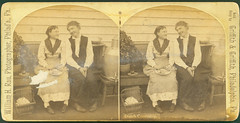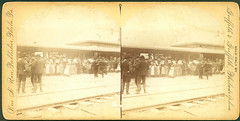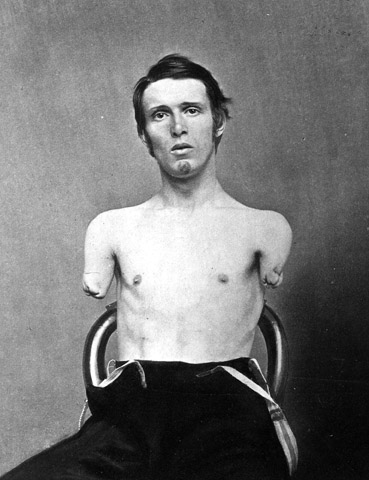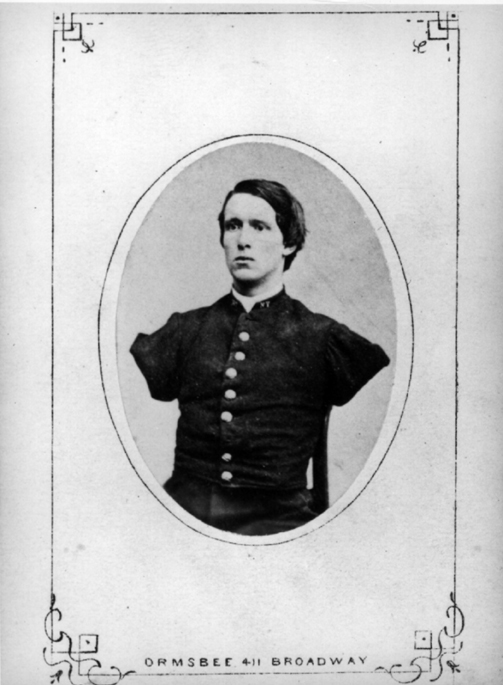
An unofficial blog about the National Museum of Health and Medicine (nee the Army Medical Museum) in Silver Spring, MD. Visit for news about the museum, new projects, musing on the history of medicine and neat pictures.
Wednesday, June 24, 2020
From Anderson’s Holler – A World War II medical photographer’s story- available now

Tuesday, March 15, 2011
Letter of the Day: March 13
De Camp General Hospital, U.S.A.,
Davids’ Island, New York Harbor,
Mar. 13th 1866
My dear Doctor,
I have sent by Adams Express Co. to the address of the Surgeon General, a box containing some photographs of surgical cases, and the histories there of rather imperfectly obtained by me from personal interviews with the patients and statements given by others. The box also contained a humerus and bullet relative to one of the cases. I likewise sent three additional photographic views of this Hospital which will complete the series taken, five of which have been previously forwarded by me to the Army Medical Museum.
Will you oblige me by forwarding a copy of Circular No 6 to the following address: Dr. S.F. Morris care of R.L. Morris, M.D., Pelham, P.O. Westchester Co., N. York.
Yours very truly
Warren Webster
Dr. Otis, +c. +c.
Monday, September 6, 2010
Letter of the Day: September 6
I have been called upon to give testimony in a criminal case - in which there is a bullet wound of the head with extensive fracture of the skull – and no external marks of violence.
Would I be asking or troubling you too much in requesting you to send me such photographs as will have a bearing upon the case, such as will illustrate the average amount of fracture of the skull from bullets, + especially pistol shots.
Also such as will illustrate well authenticated cases of fracture from “Contre Coup.”
With great respect
I have the honor to be-
Very Sincerely,
Your Obdt Servant
A. Van Deveer
^^^^
Respectfully submitted to the Surgeon General, U.S.A. for instructions. A certain number of the illustrations contained in the Army Medical Museum on the subjects referred to have been photographed and prints have been furnished to two medical men of Albany, engaged in a medico-legal inquiry – possibly the same to which Dr. Van Derveer refers.
George A. Otis
Ass’t Surg. USA
SGO
Sept. 13. 69.
^^^^
Let him have them if in hand --
Friday, July 23, 2010
Letter of the Day: July 23
Surgeon General’s Office
Washington City, D.C.
July 23d 1866
Prof. H.L. Smith
Dear Sir,
Yours of the 19th came duly to hand and I thank you very much for the growing slides. They are very ingenious and I shall value them the more as being your work. You know that the whole energy of the microscopic labor under my direction is directed towards Pathology and I only turned to the Diatomacea as test objects in developing the photographic process which we are using with the most complete success on the tissues. Still as I feel we have mastered the whole matter of microphotography, I should be glad to photograph a few more diatoms by way of showing those who are not interested in Pathology how good and reliable our process is and of inducing them to use it also. Should you therefore care to take the trouble of sending us a few specimens of carefully selected single diatoms for the Museum, we would in the course of the summer and fall undertake their photography, and cheerfully furnish you copies of our results. I think Wales really a clever young man. He has made me a number of pieces of apparatus, which with rare exceptions have given perfect satisfaction. His photographic 4/10, 1/8 and amplified leave little to be desired further. I have just received from him a 1/5 for photography, which however I have not tried. All of these lenses are made on Rutherford’s formula and can only be satisfactorily used for vision when illuminated with violet light. He is now making me a 1/16 on the same principle, from which I expect great things. He has improved enormously since I first knew him. In fact in /62 I saw lenses of his in the hands of various parties and regarded them as very inferior. It was not until 1864 that he began to make work of the highest class and I do not think that at present he would claim even to have made a 1/16 of the best quality. Barnard objects to his 4/10 that it is really a ¼ and so perhaps it is, but it is the habit of nearly all opticians to misstate the power of their lenses and I find his run quite parallel in nomenclature to those of Smith + Beck and other English opticians.
I am, Sincerely,
signedd. J.J. Woodward
Bvt. Maj. and Ass’t. Surg. U.S.A.
Friday, July 2, 2010
Letter of the Day: July 2 - Civil War photography
Mr. Trout
Please deliver to bearer sixty of the Wilderness negatives. He will designate the sixty wanted.
Yours truly,
Albert Ordway
Approved.
J.S. Billings
Surg USA
To be returned within a week
Trought has list of number sent to Ordway
This is of interest to me because we no longer have these photographs, but they were done by two cameramen of note. In 1865, Museum photographer William Bell and Dr. Reed Bontecou, a proponent of medical photography, roamed Virginia battlefields taking photographs including stereographs of the Wilderness battlefield. One hundred and twenty-one negatives of the Wilderness were taken, although 21 were missing by 1874; they had not been printed since Bell's departure from the Museum in 1868. (Otis to Keen, March 8, 1879; Otis to Bontecou, October 8, 1866; Parker to Otis, February 9, 1874, none are still in the Museum)
Monday, April 26, 2010
Letter of the Day: April 26 - the Peabody Museum sends thanks
Peabody Museum of American Archaeology and Ethnology
Harvard University
F.W. Putnam,
Curator of the Museum,
Cambridge, Mass, Apr 26 1876
My dear Dr. Otis
Many thanks for your kindness in sending me the negative which arrived today. I have sent it to Mr. Edwards without unpacking + shall have a proof from him at once. If it turns out all right would you like copies for your own use? If so I will have some sent you with the compl.[iments] of our museum as I shall have a number printed on large sheets for special distribution.
We shall greatly value the large photograph you propose sending as all we have now is one of the Cabinet rig which you sent in, which I framed + hung in the museum.
You will be pleased to know that we begin our new building at once, so I hop e in time to have a chance to arrange the museum as it should be. I shall be very much pleased to see you here + and you will kindly send me word when you are to be or in advance, for as I live in Salem + and not at the museum every day I often miss parties here unless they let me know when they are coing.
I congratulate you as arriving so near to the end of your editorial work on the big volume. It was a great undertaking + I fully know the time + attention required for such work. I hope to have some good photorelief figures of the California skulls to go in my report, and I shall be very thankful to you for the use of your measurements as you propose..
Faithfully yours,
F.W. Putnam
To Dr. G.A. Otis, U.S.A.
Curator Army Medical Museum
Washington, D.C.
Monday, April 19, 2010
Letter of the Day: April 19 - photographer job?
Office Sergeant-at-Arms,
House of Representatives U.S.,
Washington, D.C., April 19, 1888
Dr. Billings –
Dear Sir –
Mr. E.J. Taylor, a photographer, is anxious to obtain the position Assistant Photographer in the Museum.
Mr. Taylor is recommended to me, by personal friends, as an expert in his profession, and if you can possibly help him I wish you would do so – I should be glad [to] hear from you as to the prospect of his success.
Respectfully,
W.H.F. Lee
Friday, January 29, 2010
Letter of the Day: January 29 (4 of 5)
Numbered Correspondence 1215
January 29, 1896
Mr. Wayland F. Reynolds,
Clarksburg, W. Va.
Dear Sir:
In answer to your letter of the 28th inst., I would state that there is in this Museum a microscopic slide which contains the Lord’s prayer, 227 letters, in a space 1/294 x 1/441 of a square inch.
Very respectfully,
D.L. Huntington
Deputy Surgeon General, U.S. Army,
In charge of Museum and Library Division.
Letter of the Day: January 29 (1 of 5)
The photographs he refers to have not been catalogued and may no longer exist. Darn it.
County Clerk’s Office
John C. Johnston,
County Clerk
Newton, Kas. Jan 29, 1885
David Flynn
Army Medical Museum
Washington City DC
Dear Sir
If you remember I was in your Department last May (1884) and you had me photographed. I am the original of Cast No 1401 Shell wound in right side of my face, Battle of Spotsylvania CH [Court House] May 10 1864. You gave me several phots. But you said if I would write you would sand me some better ones when you had more leisure to get them up. If it is not asking too much I wish you would please send me ½ doz. of each side. I had both sides of my face taken etc.
Yours Truly
John C. Johnston
Newton PO
Harvey Co.
Kansas
[1 doz Photographs sent April 9, 1885]
Thursday, December 10, 2009
Jim Edmondson on 'Dissection' on Lopate radio show
Dissection
Author James Edmonson, Chief Curator of the Dittrick Medical Center and Museum at Case Western Reserve University, explains why, in the nineteenth century and into the twentieth century, medical students took pictures of themselves with the cadavers they dissected. His book Dissection: Photographs of a Rite of Passage in American Medicine includes 138 rare, historic photographs that reveal a strange piece of American medical history
Thursday, October 15, 2009
Blog tip - Civil War Medicine (and Writing)
Tuesday, September 8, 2009
On a couple of nondescript stereographs

The 'Dutch Courtship' was probably intended to be humorous.

This crowd scene is meaningless now without its caption.
So, why did I buy these?
Both are by William H. Rau.
So?
He was William Bell's son-in-law. Bell was the Museum's best photographer of the 19th century who took photographed many of the Civil War soldiers at the Museum. He was the subject of a small exhibit at the American Art museum last year.
Thursday, April 30, 2009
New Walter Reed hospital photo book by Archives staff
1) Walter Reed Army Medical Center Centennial: A Pictorial History – “A profusely illustrated history covering the full range of WRAMC’s activities in service to the Army and the Nation.” Hardbound. Over half of the photographs are from the Museum’s collections, and Museum archivist Kathleen Stocker was the photographer for some of the views of the buildings of the current campus.
· S/N: 008-000-01020-0
· Price: $35.00
· Link: http://bookstore.gpo.gov/actions/GetPublication.do?stocknumber=008-000-01020-0
2) Borden’s Dream – “An engaging history-memoir covering WRAMC’s early history, filled with stories about the people and events that shaped its evolution as an institution.” Hardbound.
· S/N: 008-023-00135-9
· Price: $55.00
· Link: http://bookstore.gpo.gov/actions/GetPublication.do?stocknumber=008-023-00135-9
We helped find replacement photographs for some of the missing images in the typescript copy of Borden's Dream.
A display is in the hospital lobby and May 1.
Monday, April 27, 2009
Dissection photos book review
Friday, March 20, 2009
Plastic surgery exhibit in NYC
EXHIBITION OPENING
I am Art - An Expression of the Visual & Artistic Process of Plastic Surgery
Curated by Dr. Anthony Berlet
March 28 - May 9, 2009
Opening reception:
Saturday, March 28, 6-8pm
Presenting work by Anthony Berlet, M.D., Antonino Cassisi, M.D., Michael Cohen, M.D., Scott Spiro, M.D.
Leon Dufourmentel, a pioneer in plastic surgery, said in 1948, “...If I went to Picasso for my portrait, he would probably make me a monster and I should be pleased because it would be worth a million francs. But if Picasso came to me with a facial injury and I made him into a monster, aha, he might not be so pleased.”
This quotation expresses our view, which we hope to share with you in this exhibition, that plastic surgery is a most challenging art form—perhaps the most challenging art form, for our materials are not canvas or clay. Yes, we embrace the great obsession of artists throughout the ages: the human body. But our material is the human body.
We are asked, on a daily basis, to do the impossible, to make the real ideal, to bridge the gap between reality and fantasy. Plastic surgery is the constant struggle between beauty and blood supply
There is art in everything we do. The initial evaluation requires a keen eye. The surgery plan requires artful preparation. The execution can best be described as a well-choreographed ballet of many different steps. Through this dance of medicine and art, science and aspiration, we seek an outcome as beautiful as any painting or sculpture. Every day, we strive to outdo Pygmalion.
Is perfection possible? We know it is not, and yet, that is our calling. We work with terrible constraints, not the least of which is the subjective nature of art itself. Nowhere are human feelings more various and more complex than in perceptions of the body and of the self. We are, all of us, acutely aware of how others see us.
Our field is sometimes associated with excess. We hope to convince you otherwise. For each individual committed to our charge, the stakes could not be higher. In this exhibition, we intend to convey the great care with which we diagnose, counsel, prepare, execute and maintain our artistic creation, with vision, clarity, passion, ingenuity, compassion and, yes, art.
This exhibition will show the many ways in which we express ourselves as artists, borrowing and shaping perceptions. Take a moment to step into the experience of others, whose lives have been transformed at our hands, we trust for the better.
We hope you will come away from our exhibition with a fuller sense of our aesthetic, reconstructive and post-traumatic disciplines. In the gallery space, we want to give you a glimpse into our world, which is never our world alone. Ours is truly the most intimate, the most personal of arts. When we are finished, the product of our labors can turn to us and say, "I am art." That, at least, is what we strive for.
Please join us.
All events are free and open to the public.
apexart
291 Church Street, NYC, 10013
t. 212 431 5270
www.apexart.org
Directions: A, C, E, N, R, W, Q, J, M, Z, 6 to Canal or 1 to Franklin.
apexart's exhibitions and public programs are supported in part by the Andy Warhol Foundation for the Visual Arts, Carnegie Corporation of New York, Edith C. Blum Foundation, Mary Duke Biddle Foundation, The Greenwich Collection Ltd., The William Talbott Hillman Foundation, and with public funds from the New York City Department of Cultural Affairs and the New York State Council on the Arts.
Friday, January 2, 2009
Photographs of Museum specimens on French blog
Tuesday, December 9, 2008
The Burns Archive
For the past thirty years, Dr. Burns has collected more than 700,000 photographs from the 19th century. Among these are 60,000 medical images that include dageurreotypes, ambrotypes, and tintypes from 1840-1860, but he also has strong collections in African-American photographs, wounded Civil War soldiers, Judaica, and war images from the Crimean to World War 2 (plus many other genres; check out his website).
Included in the box with Deadly Intent was a tiny paper packet
 from Dr. R.B. Bontecou, a Civil War physician and photographer who traveled to battlefields, documenting injuries with his camera. The packet was designed to hold an antiseptic bandage, which Bontecou called the Soldier's Packet for First Wound Dressing. That will go into our GMPI (General Medical Products Information) collection and the book, along with the others he has sent us, lives on a shelf in the archives.
from Dr. R.B. Bontecou, a Civil War physician and photographer who traveled to battlefields, documenting injuries with his camera. The packet was designed to hold an antiseptic bandage, which Bontecou called the Soldier's Packet for First Wound Dressing. That will go into our GMPI (General Medical Products Information) collection and the book, along with the others he has sent us, lives on a shelf in the archives.Thank you, Stanley.
Tuesday, August 5, 2008
Limb lab continuation - that Civil War amputee
Here's the medical museum's photograph of Stratton:

And the cartes-de-visite Stratton sold to support himself:

This paper has pretty much everything I know about the Museum's Civil War photography and is one of my favorites of articles I've written.